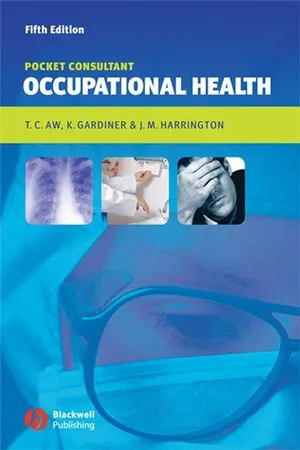Repetitive Strain Injury
Repetitive Strain Injury (RSI) refers to a condition caused by repetitive movements and overuse of muscles, tendons, and nerves. In the context of computer science, RSI commonly affects individuals who spend long hours typing or using a mouse. Symptoms may include pain, stiffness, and numbness in the affected areas. Prevention and treatment often involve ergonomic adjustments, regular breaks, and exercises to reduce strain.
3 Key excerpts on "Repetitive Strain Injury"
- eBook - ePub
Managing Health at Work
A Guide for Managers and Workplace Health Specialists
- C. Wilkinson(Author)
- 2020(Publication Date)
- CRC Press(Publisher)
...8 Repetitive Strain Injury Introduction: defining RSI ● Predisposing factors to RSI and links with the workplace ● Visual display unit operators ● The meat packing industry ● Prevention and workplace adjustments ● Summary ● Suggested further reading ● References ● Useful addresses ● Notes INTRODUCTION: DEFINING RSI Bernardi Ramazzini (1713) was the first to detect what is known today in Britain as Repetitive Strain Injury (RSI). The principle causes of this condition relate to psychological stress, working posture and repetitive motions. It is predominantly linked with the workplace. The type of work performed over the years has led to an increasing recognition of the problems particularly relating to musculoskeletal activity. This includes machine pacing and the Taylorist fragmentation of tasks with its series of repetitive motions. The condition of Repetitive Strain Injury has not been an easy one to define as there are a number of musculoskeletal disorders associated with the neck, shoulders, arms and hands. This has led to controversy in the field of study. However, the most notable terms come from a variety of sources. occupational cervicobrachial disorder (OCD) - Japan upper limb syndrome shoulder arm syndrome overuse syndrome - Scandinavia cumulative trauma disorders (CTDs) - USA and Canada neck and upper limb disorders (NLDs) Repetitive Strain Injury (RSI) - origins in Australia, later taken up by the UK Neck and limb disorders (NLDs) were originally defined by Kuorinka and Viikari-Juntara in 1982, and divides the symptoms of the condition in working populations into five categories. Temporary fatigue, stiffness or soreness of the muscles comparable to the muscle pain of athletes. Long-lasting pain in the muscles, and tendons. Symptoms relating to fibrosis of the muscles, that is, pain and swelling. General disease with musculoskeletal symptoms, e.g...
- eBook - ePub
Occupational Health
Pocket Consultant
- Tar-Ching Aw, Kerry Gardiner, J. M. Harrington(Authors)
- 2013(Publication Date)
- Wiley-Blackwell(Publisher)
...The term RSI encompasses a variety of clinical entities, all of which can present with pain and discomfort, are associated with repetitive movements and are attributed to or made worse by work factors/activities. Some of these are: tenosynovitis; de Quervain’s disease; peritendinitis crepitans; carpal tunnel syndrome (wrists); epicondylitis (elbow joints). Clinical features Persistent pain and discomfort of the muscles, tendons or soft tissues of the limbs. Swelling, tenderness and other features, indicating inflammation, may be present, especially in the acute stages. Crepitus may be present on examination. Tingling sensation and numbness, especially with accompanying peripheral nerve involvement. The symptoms can be acute, recurrent or chronic. Relevant exposures Dynamic load—repeated, frequent movements of the limbs over a prolonged period (as over an 8 h working day with limited rest periods). Movements throughout the full range of motions at the joints, for example from full pronation to full supination and back. Awkward postures and/or postures at the extremes of the range of movement, for example hyperflexion or hyperextension, or ulnar/medial deviation at the wrist. Static load, for example using the limbs to support weight, or holding the limbs against force or pressure, for sustained periods of time. Other contributory factors The extent to which some of these factors contribute to the occurrence of RSI remains debatable. Non-occupational factors. Where repetitive movements and other relevant exposures also occur from non-occupational activity, such as hobbies or household chores, these exposures can contribute to the clinical effects. However, with hobbies in particular, there is a degree of control over discontinuation of these non-occupational activities if necessary. Similar control may not be available in carrying out work tasks. Previous injury affecting the same sites may predispose to pain and discomfort...
- eBook - ePub
- Robert Bridger(Author)
- 2017(Publication Date)
- CRC Press(Publisher)
...Perceived muscular tension has been found to predict neck–shoulder and hand–wrist symptoms in office workers (Huysmans et al., 2012) over a period of 2 years (OR 4.4 for neck–shoulder problems in often tensed workers and 2.3 for hand–wrist symptoms). Summary Despite automation and computerization of work, WMSDs are still prevalent and repetitive work is common. The occupational risk factors for WMSDs when work consists of simple physical tasks are well understood and usually modifiable by better design. In office-based service industries, the role of physical risk factors is less clear. Dick et al. (2011) report that there is little evidence that altered keyboards with different geometry were effective against CTS; limited but good evidence that multidisciplinary interventions for nonspecific arm pain were beneficial; limited evidence that modified keyboards were effective in reducing symptoms of tenosynovitis; and insufficient evidence to inform workplace management of lateral epicondylitis. Valid and reliable tools are available to carry out risk assessments but they are tools not rules and their interpretation should be based on a proper understanding of the task and the work environment, including psychosocial factors. A revised version of the Strain Index has recently appeared (Garg et al. 2017). Tutorial Topics 1. Does “RSI” exist? 2. If a worker experiences pain at work, it must be the work that caused it. Discuss. 3. “People should finish work in the same state of health as when they started.” Discuss. ESSAYS AND EXERCISES 1. Obtain a number of commercially available screwdrivers and a large piece of hard wood. Using friends or colleagues as subjects, time how long it takes them to screw in a standard size screw with each screwdriver. Use five screws per screwdriver per person and take the average time for each person per screwdriver combination (use a different screwdriver after each screw to balance out fatigue effects)...


